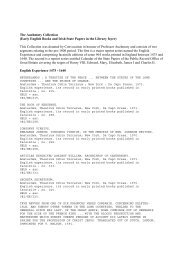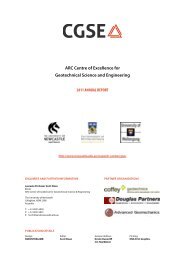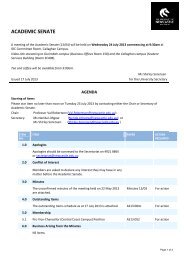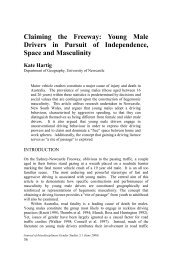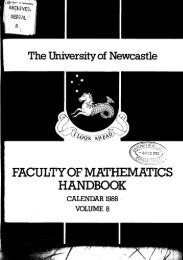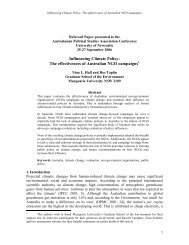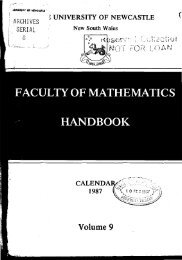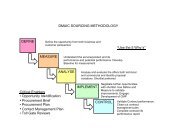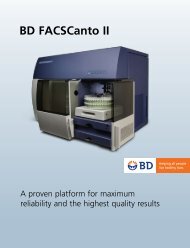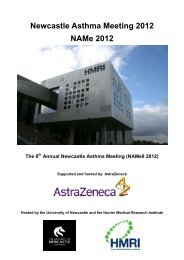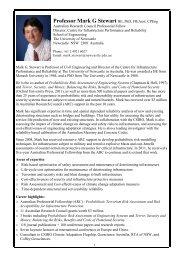n - University of Newcastle
n - University of Newcastle
n - University of Newcastle
You also want an ePaper? Increase the reach of your titles
YUMPU automatically turns print PDFs into web optimized ePapers that Google loves.
-<br />
6 AX AUSTRALIAN I~ANGUAGE. THE JIIXTUSG DIALECT. I<br />
The adjective cluk kai, ' dead,' takes numerous forms ; thus :-<br />
2, dukkai, dukkai-hint; 3.,touara-gun, dukkai-guilt, dnkkai-bin-<br />
gnnt, clukkai-gun-bint; 4. dukkai, dukkai-bint.<br />
Nouns ancl adjectives do not change their form to denote number.<br />
The ~vord paigal may niean one 'man,' or any number <strong>of</strong> !men.'<br />
With regard to the pronouns, some <strong>of</strong> them are singular, sollle<br />
dual, some plural, and sonle <strong>of</strong> them indefinite so far as number is<br />
concerned. The nunlber <strong>of</strong> a noun is generally known by the use<br />
in the same sentence, or in the context, <strong>of</strong> a singular, dual, or<br />
plural pronoun, or hy the scope <strong>of</strong> the sentence or other surrounding<br />
circumstances.<br />
3. GESDER.<br />
Tliere are tn-o mays by which the fenlinine is distiuguished from<br />
Ihe mascnline--either by a different word or by adding the termination<br />
-gin, <strong>of</strong> mliich the zl is aln~ays short ; as :-<br />
~lfasculbze. Fe~sinitle.<br />
Iiobi, ' a blind man.' Alobi-gun, ' a blind u-omal~'<br />
Yerubilgin, 'a inale singer.' Ykrubilgin-gun, 'a female sillger.'<br />
ICi6on1, 'old man.' i\!errug, ' old woman.'<br />
Gubbo, ' boy.' Yagari, ‘ &I. '<br />
Koroman, male 'kangaroo.' Imarra, female 'kangaroo.'<br />
I'BOA'O LrATS.<br />
These are :-(1) Personal pronouns, (2) demon strati^-es, (3)<br />
Inclefiuite pronoulls, (4) Numerals, ancl 5) Intei-rogatires.<br />
Personal pronozcizs.<br />
Si~zgzclcir. Gai, 'I.' TlT6, 'thou.' Nyuly, 'he'; nyan, slie.'<br />
Pkcrnl. Gully, ' we.' Buly, 'you.' &mnaby, 'they.'<br />
The Minyng has no siml>le dual, although there are compound<br />
terms and phrases denoting the dual number ; such as, gulliw 6,<br />
g ullibula, 'we two'; me gerrig, 'you two,' 'you and another.'<br />
The personal fornls <strong>of</strong> hula are sometimes used as dual pronouns;<br />
as, bulaily, 'they two,' i)ec~c., ancl buiaili-gun, 'they<br />
two, fena. ; and even such phrases as TVB gerri g bnlail y and n k<br />
gerrig bulaili-gun, 'you two,' are used.<br />
D~no~zstratiues.<br />
Besicles these, there is a peculiar class <strong>of</strong> words, which may be<br />
called demonstratives. When used as predicates, they have the<br />
general meaning <strong>of</strong> ' here,' ' there,' or ' yonder.' They are <strong>of</strong>ten<br />
used as demonstrative adjectives, and then mean this,' ' tliat<br />
'these,' 'those.' As such, they usually agree hi for111 \vitL tl~u nouns<br />
which they qualify, that is, they take silnilar su~xes. Oft,en,<br />
horn-ever, the noun is omitted, and then they become true l~t.t.~~llill<br />
11ronouns, retaining whatever sudix they ~~oulil hare if the noun<br />
were used. For example, the TI-orcl kully, used as a llreclicate,<br />
meaus 'here'; as, paigal kully, 't~zllaliishere'; butpaigal kully<br />
y ily ul means ' this man is sick '; and, onlitting l~iligal, k nll y<br />
yilyul means 'he is sick '; kully thus means ' here '; 'tl~is ' 't,lic:';<br />
'he here'; 'she here'; and 'it here.'<br />
Such worcls are real clemonstratives, and must he carefully clis<br />
distinguished from ordinary adverl~s <strong>of</strong> place; for, <strong>of</strong>ten ail aclrerll<br />
<strong>of</strong> place is, as it \%-ere, pronlotecl to the rank uf a cleiuonstrativt.,<br />
and in this \my it may collie to take the place <strong>of</strong> a personal 1)r~noun.<br />
This nlay account for the fact tliat tl~e third l~ersona!<br />
pronouns are so numerons, and hax-e little or 110 etymoiogic:~l tollnection<br />
in Australia11 dialects. These c1emonstrati~-es are k u 11 y,<br />
mullg, killy, kuncle, kanyo, mun, tam, kaka, ka, iuld k~l~a.<br />
As these are soinetinles doubled or recluplicated and hare sonle other<br />
rariations in £om, the followillg scheme may hc- convenient :-<br />
Si~zyzclcc~r. I'l~wal.<br />
I.-ICully, ku-kully, 'this '; ' tlie '; \<br />
'he (she, it) here '; 'this here.' Xiu~yo ;<br />
11.-Kulla-na-gun, this j; she here.. ,soaLr&rxx<br />
111.-IConno, ko-konno, ' this '; 'it, here,' 11iiin.<br />
IT.-Kully, ku-kully ; kukai ;<br />
kullai, ku-kullai ; 'here.' I<br />
I.--Mully mu-mully, 'that '; ' the ';<br />
' he (she, it) there.'<br />
11.-Blulla-na-gun, 'that '; ' she there.'<br />
111.-&fonno, ' it there.'<br />
IT.-Blully, mu-mully ;<br />
mullai, mu-mullai ; 'there.'<br />
I.-Killy, ki-killy, ' yo11 '; ' he ';<br />
' he (she, it) yonclel-.'<br />
1<br />
li;imo, ka-k$luo,<br />
soi)aetii~zes<br />
!



